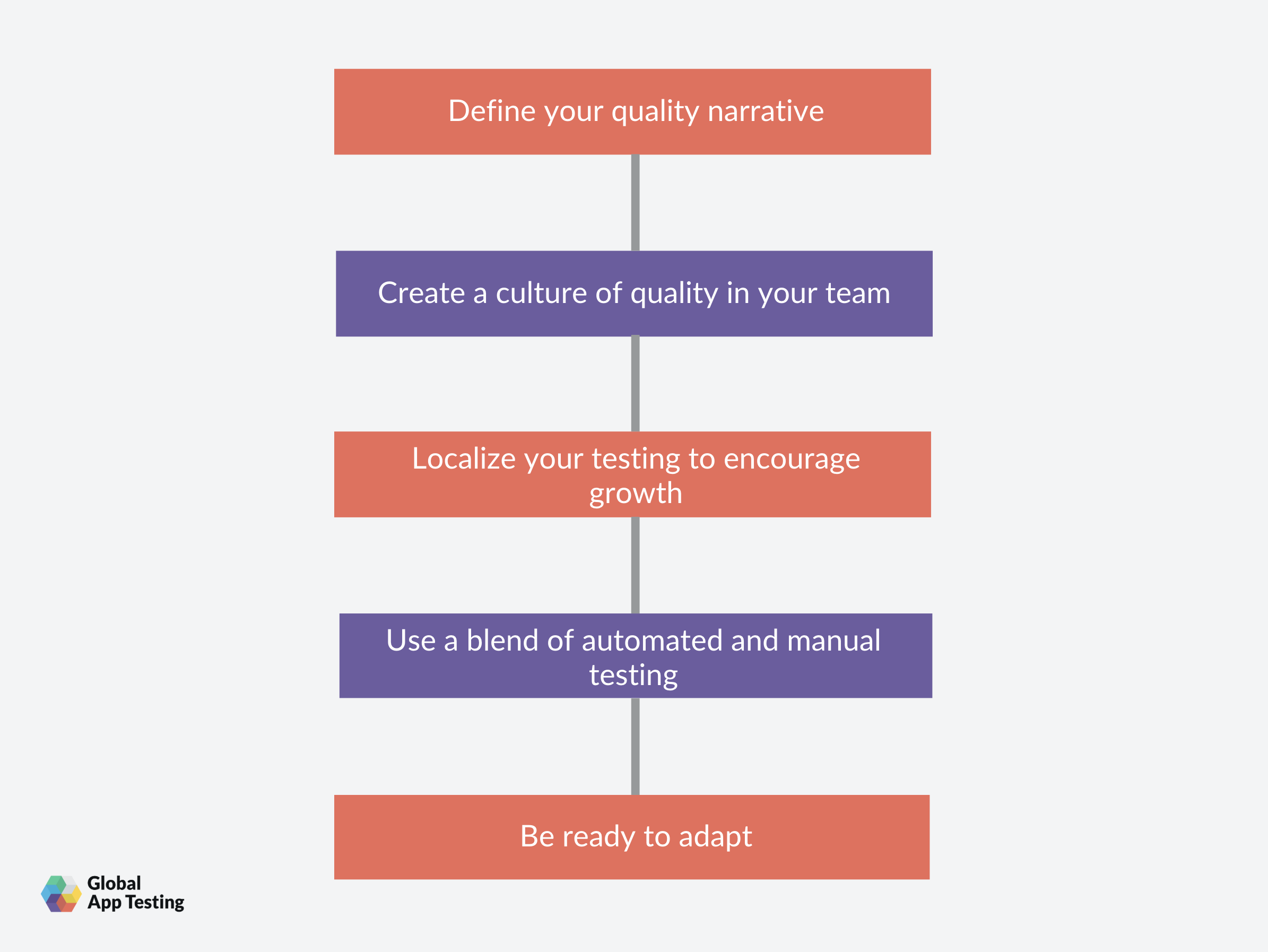Across all industries, 71% of app users churn within 90 days. That’s a large number of users deleting an app when it doesn’t quite meet their expectations. But, by delivering a high-quality, bug-free app, you can dramatically reduce the likelihood of this happening.
Customers are looking for an app or web page that works seamlessly, processes fast and looks great. To achieve this, you need to implement a structured quality assurance (QA) strategy that puts quality at the forefront of your development process, as well as integrating effortlessly into your DevOps workflow. A poorly tested software product will most likely contain bugs, performance issues and even localization problems that developers may have missed. An app that’s undergone thorough quality control checks will increase customer retention, grow your business and deliver a user experience worth shouting about.
Follow these five steps to building the ultimate QA strategy to ensure your company delivers quality at every level.
1) Define your quality narrative

What does this mean?
A quality narrative is simply the way that you think and talk about quality in your company – not just your software development team. Whether you know it or not, this narrative exists, and it’s important to align it within your company so that you can approach a QA strategy effectively. From your stakeholders to your sales reps, having an aligned view of quality leads to a shared vision. This shared vision will help everyone focus on the same goals.
What actions should you take?
To build the ultimate QA strategy, you first need to take stock of your current quality narrative.
In Leading Quality, our Amazon best-selling book, we interviewed hundreds of leading brands about their approach to quality. We identified three types of quality narratives that companies recognize. Determine which one your company falls under, and you will be able to identify what needs to change.
1. The Ownership Narrative
The Ownership Narrative is all about discussions around who is responsible for the quality of the product.
What makes a good Ownership Narrative?
In short, this occurs when teams recognized the level of interdependence between them.
A siloed QA strategy, with the responsibility falling solely on the testing and engineering teams, does not encourage a positive quality narrative as a whole. An “it’s their problem” mentality will only slow your company’s growth. Recognizing if this is a problem is an essential step in developing your strategy – and ensuring your product meets customer expectations.
2. The “How to Test” Narrative
The “How to Test” Narrative is about discussions around what the right ways to test are. The key questions are “how will we test this?” and “what tools can we use?”
What makes a good “How to Test” Narrative?
A positive “How to Test” Narrative does not over-rely on one type of testing. QA is a problem-solving task, so it is crucial to think about what the best testing process might be for each scenario. Having a clear understanding of the different options, and ways to test, will help you make informed decisions about how you should implement your testing.
This is all about making sure QA testing teams don’t develop a silver bullet mentality, believing they only do one type of testing and one type only. One size does not fit all, and your testing toolkit should be broad to ensure you are not trying to fit a round peg in a square hole!
3. The Value Narrative
The Value Narrative focuses on the value that quality brings to the company. It’s all about the revenue potential that investing in quality can have.
What makes a good Value Narrative?
To develop a positive Value Narrative, you need to persuade management to recognize the tangible value of quality (and a quality assurance process). Set key performance indicators and metrics for your team that reflect the QA team’s potential. Demonstrate how a developed QA strategy will lead to an improvement in customer experience, faster time to market and higher app retention. Highlighting standards like ISO 9001 and what a certification might mean can show the value of high quality standards. When the entire company understands the real value of QA, investment in it will grow.
What’s your quality narrative?
It’s time to uncover your quality narrative and assess your current situation. Why not ask different colleagues to share the top three comments they hear about quality within your company? Try to speak to people at every point in the development cycle, as well as those outside it. Once you better understand your company’s attitude towards QA, you will be able to see where you are and start thinking about where you want to be. Knowing what your quality narrative may currently be, you can start to think about what is right about your current quality narrative – and what may need to change.
2) Create a culture of quality within your team

What does this mean?
A culture of quality is all about having an aligned vision, with shared responsibility for quality. Once you have defined your quality narrative, you then need to work on creating a quality culture that is beneficial for your business.
What actions should you take?
If your quality narrative is not entirely where you want it to be, you may need to put energy into creating a quality culture in your company. Here are four steps to take:
- Understand the individuals you need to influence: Think about what the goals and objectives of each person in your team are. Do they care most about usability? Are they thinking about the end-user or the client more? Once you have understood these, you will be better equipped to recognize how you should frame discussions around QA with your colleagues.
- Create empathy to increase alignment between teams: Ensure that there is cross-team empathy and understanding. If you’re following an Agile methodology, collaboration should be key. Think about implementing cross-functional pairing sessions, where those from different disciplines work together to share ideas and avoid misalignment in the future.
- Support your quality narrative with evidence: To add weight to your ideas, you need tangible proof that investing in quality will lead to significant ROI. Gather evidence to add credibility to your proposals and design documents.
- Cultivate internal champions: Foster relationships with members of your company who put quality at the forefront of their minds. Anyone who recognises the importance of quality is an ally, and working with them will help foster a quality culture – and a quality final product.
Once you have made your way through these four steps, you will be best placed to put actionable change into place. With cross-functional teams, the support of internal champions and alignment across your company on what quality should look like, developing your QA strategy will be much easier.
3) Localize your testing to encourage growth

What does this mean?
Localization testing ensures that your product works as effectively in a new language or environment as it does in the language and environment it was originally written.
Building localization into both your software development process and your QA strategy is crucial to global growth. Delivering an end product tailored to markets across the world will ensure a better customer experience for new users. It’s important to have quality management systems in place that take local insights into account.
What actions should I take?
The ultimate QA strategy takes localization into account at the early development stage of your app. When releasing an app in the US alone, you cover six time zones and 50 states. That’s a huge area to cover, and each state will have language and cultural nuances. By testing these with local insights, and building them into your app, you can deliver a more personal customer experience.
Even if global growth isn’t on your mind for the immediate future, you need to put the steps in place early to make sure there are no bottlenecks later in the life cycle of your product. Building scalability, as well as functionality, into the process ensures that new markets will be easier to reach when the time comes.
4) Use a blend of manual and automated software testing

What does this mean?
If your current software quality assurance strategy features solely automated or manual testing, you might need to rethink it. A well-rounded QA strategy should include a blend of automated and manual testing. It should not be a ‘one or the other’ decision.
What action should you take?
In certain situations, like where a test case is easy to automate, or the cost of automating is lower than executing the test manually, it is beneficial to use automation. However, it is not always the only way to run a test. Often, the creativity of humans is required for QA activities. For example, in order to conduct exploratory testing, where testers are given relatively free rein to explore an app and try and uncover bugs, human testers are required in order for the process to work.
5) Be ready to adapt your QA strategy
What does this mean?
A good QA strategy is structured enough that it delivers results, but not too structured that it leaves no room for change. Updating and refreshing your QA strategy is crucial to its success.
What actions should you take?
Maintaining quality throughout the software engineering process, and as your product matures and changes is a huge challenge for companies. Your team must be ready to adapt as your product changes, and your company grows. A QA strategy that worked when you had 1,000 users won’t work the same when you have 50,000 users in 10 countries! You might have met those quality requirements at the start, but you need to meet them consistently. Being ready to scale up your plan and be flexible with changes is a fundamental part of developing a well-rounded approach to quality.
By following these 5 steps, you will be able to create the ultimate QA strategy, and if your QA processes are of the highest quality, you are guaranteed to see growth. Remember:
- Define your quality narrative
- Create a culture of quality in your team
- Localize your testing to encourage growth
- Use a blend of automated and manual testing
- Be ready to adapt

Hear from the professionals
We’ve compiled 4 top tips from QA professionals who have offered their advice on how to build the ultimate QA strategy. Here they are:
“Nowadays, automated testing is favoured over conventional functional and exploratory testing, even with very low ROI. We should automate only when it significantly reduces the regression time.”
Kuldeep Rana, Founder of ArtOfTesting
“Quality has to be front and centre. Lay out a clear process. Put it on the wall in the office if it helps. Make it plain and simple to follow”
Justin Dring, Senior Consultant at PSE Ltd
“To create a successful QA strategy is to adapt it to the peculiarities of a given project and design the QA process with the following factors in mind:
1. Organizational specifics, for instance, an organization and project team structure, quality management, risk management, change management and other processes established at an organization and project levels, etc
2. Domain specifics, for example, logical and technical specifics of software, the peculiarities of the user flow.
3. Software requirements specifics, including both functional and non-functional requirements.
4. Release plan specifics that influence the scope of work a QA team is to deliver by a given deadline.”
Andrei Mikhailau, Software Testing Director at ScienceSoft
“We are currently building a QA Strategy for a medical statistics company and have built them in the past for other organisations. While they usually have some standard sections, the most important part, from our point of view, is to make them fit the organisation to which they apply. As such we use an open-ended questionnaire to elicit: Relationship to QA; Inputs to QA; Expectations from QA; Level of Decision Making; Types of Testing expected from QA; Best Deliverable from QA; Most lacking Deliverable. We then craft the Strategy to cover the needs of the organisation.”
Neil Price-Jones, President at NVP Software Solutions
Download our Ultimate QA Testing Handbook.
Download our Ultimate QA Testing Handbook to guide you through everything you need to know to release high quality products faster and more frequently – all in one place.
Global App Testing are exhibiting at EuroSTAR 2021 and we’d be delighted to welcome you and your team to this year’s EuroSTAR Software Testing Conference. Check out the offers currently available.
You can also explore the additional testing resources – webinars and eBooks that we have here on EuroSTARHuddle.com
